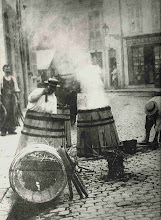
All of our wood for Oregon Oak barrels is air-dried for minimum of 36 months. The wood is stacked outdoors with space left between each stave. The rain along with mold, bacteria and yeast breakdown the tannins of the wood. This air-drying, really weather seasoning yields softer tannins in the wine. The air-drying also eliminates “green” wood flavors.

We have experimented with 18 month, 24 month and 36 month air-drying and have come to the conclusion that Oregon Oak needs at least 36 months. Talk to any one who tried our 18-month air-dried barrels and I think they will agree.

The down side to the extending air-drying, besides tying up a lot of capital, is that each year of season will result in lower yields. Another downside to 36 month air-drying is that we have to make sales projections three years out. Not only how many barrel but also what shape. Staves for Burgundy barrels are cut 90cm; Bordeaux barrels 100cm and 400 liter barrels are cut to 105cm.




